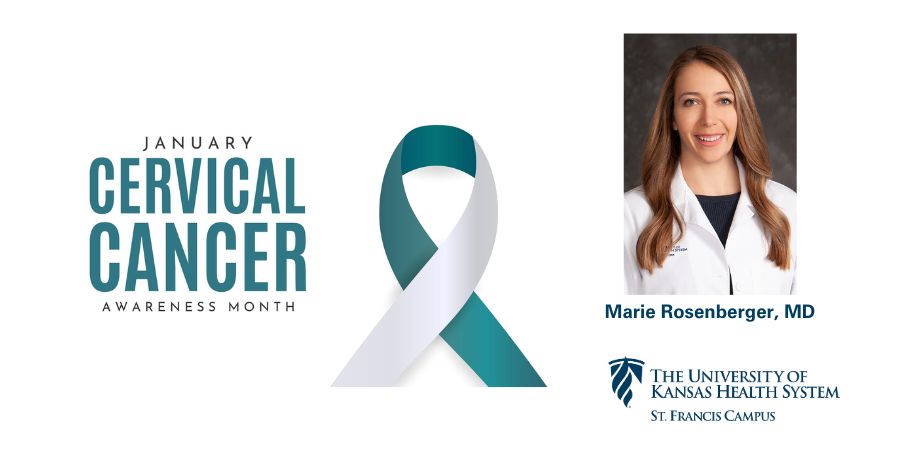Q&A with Dr. Marie Rosenberger: Cervical Cancer Awareness
January marks Cervical Cancer Awareness Month, a time dedicated to raising awareness about the importance of cervical health and encouraging regular screenings. Once a leading cause of cancer-related deaths among women in the United States, the impact of cervical cancer has significantly diminished due to effective screening and prompt treatment. However, according to the National Cancer Institute, approximately 13,960 women in the U.S. were diagnosed with cervical cancer last year, resulting in over 4,310 lives lost.
Dr. Marie Rosenberger, an OB/GYN at The University of Kansas Health System St. Francis Campus Women's Center, answers a few questions about cervical cancer, screenings, symptoms, and preventive measures.
What is cervical cancer and are there symptoms in the early stages?
Cervical cancer originates in the cervix, the opening to the uterus and connects to the upper part of the vagina. Abnormal cervical cells can take three to seven years to develop into cancer, often without noticeable symptoms. Screening with pap smears and HPV tests is crucial as it can detect abnormalities or HPV infections before the onset of symptoms.
Potential signs of cervical cancer include pelvic pain, abnormal vaginal discharge, and abnormal vaginal bleeding (e.g., bleeding after sex or between periods). Early detection through screenings significantly improves the chances of successful treatment.
What types of cervical cancer screenings are available and how often should I be screened?
Regular screenings are vital for anyone with a cervix. Screening methods include pap smears, Human Papillomavirus (HPV) tests, or a combination of both. These screenings involve a vaginal exam with a speculum to view the cervix, located in the upper vagina. A small brush is used to collect cervical cells for laboratory testing. Pap smears detect abnormal cells that could be pre-cancerous or cancerous, while the HPV test identify the presence of the virus, a common cause of cervical cancer. While many people may have had a pelvic or vaginal exam before, it may not have included the specific testing for a Pap smear, especially if you were evaluated at an emergency department or for an acute visit. Please be sure to check with your provider to see if you are due for screening.
Screening should start at age 21, regardless of when you first started having sex, and continue every three years until age 30. Screenings can occur every three years or every five years if you are also tested for the HPV virus at the time of your pap smear. Those with weakened immune systems, a history of cervical issues, or specific medical conditions may require more frequent screenings.
What is HPV and what is the HPV vaccine?
Human Papillomavirus (HPV) is a virus that can lead to changes in cervical cells, increasing cancer risk. 91% of cervical cancers are caused by HPV. Other common cells in your body that can also be affected include the vagina, penis, anus, mouth and throat. HPV can also cause genital warts. HPV is the most common sexually transmitted infection with approximately 75-80% of sexually active people being exposed in their lifetime. Most people show no symptoms. It is important to talk with your sexual partners about their history and use barrier methods, such as condoms or diaphragms to prevent becoming infected with any sexually transmitted infection, including HPV.
There are more than 150 strains of HPV, but only a few have a high risk of causing cancer. The HPV vaccine, commonly known as Gardasil, helps protect against the most common high-risk strains of HPV that cause any cancer related to HPV. It works best if you have never been exposed to HPV before but is beneficial even if you have had previous exposure or infection. The vaccine is approved for females and males ages 9-45. Depending on your age, the vaccine is given in a series with 2 or 3 shots spaced months apart. While this vaccine protects you from the most common types of HPV, it does not protect against all types, so you should still get regular cervical cancer screening.
What happens if my cervical cancer screening test result is abnormal?
If you have an abnormal cervical cancer screening the next step is some additional testing to evaluate the abnormal cells are. Depending on the severity of your abnormal screening, you may just need more frequent pap smears, or possibly having a healthcare provider look at your cervix with a microscope and collect a small biopsy (called a colposcopy), which is completed in the office. An abnormal result does not mean you have cancer. Many times, abnormal changes can go back to normal on their own. If not, it often takes years for abnormal cells to become cancerous. The benefit of regular screening is that abnormalities are caught early and can be addressed before they turn into cancer.
Cervical cancer screenings can be performed by a primary care provider or an OB/GYN. Our primary care and OB/GYN specialists are accepting new patients. Call 1-833-4NEWDOC (1-833-463-9362) to schedule an appointment.




